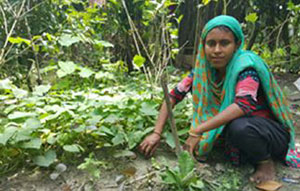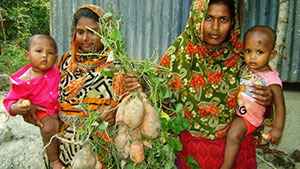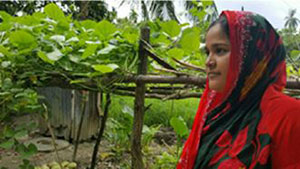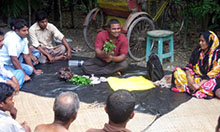Bringing This Nutritious Crop to Homestead Farmers in Bangladesh

Vine Cuttings for Better Health
“Komla misti alu (orange-fleshed sweet potato) is the tastiest of all nutritious food we have grown in our backyard,” says Nilufa, who lives in Barisal Division. She is among the thousands of recipients of orange-fleshed sweet potato (OFSP) vine cuttings, distributed by SPRING/Bangladesh. She continues, “My child used to eat unhealthy snacks, but now I give him boiled komla mistu alu. He really enjoys it!”
The promotion of OFSP cultivation began as a pilot to add an additional high nutritional value crop to the diet of farmer nutrition school (FNS) members and other surrounding households. In 2016, SPRING distributed OFSP vines to nearly 12,000 FNS members across Barisal and Khulna Divisions, making OFSP accessible to many poor women farmers for the first time. After an initial successful pilot cultivation, the SPRING FNS members took it upon themselves to distribute these vine cuttings to more than 8,500 additional farmers (FNS members). Because it is nutritious and can be cooked in many ways, cultivating OFSP quickly became popular.
Komla misti alu has been tremendously beneficial to me. Not only do I have access to a highly nutritious food, but I have also made significant financial profit selling the sweet potatoes.
--Rajia Begum, FNS member
A Versatile Food

Speaking about the culinary versatility of OFSP, the mother-in-law of an FNS member says, “The variety of food items that can be prepared with komla misti alu is great; it can be eaten boiled, fried, or as bhorta (mashed). Not only do we eat the potato, but also the leaves and the stem are incredibly tasty and nutritious. I use the leaves when cooking khichuri (yellow curry rice).” She also said that when the potato is mixed with flour it can be baked into a roti (flat bread) or used to make traditional Bengali desserts, such as halua (a kind of sweet porridge).

FNS Members Spread the Word
Although SPRING was not the first project to introduce OFSP in Bangladesh, it was happy to help rejuvenate the spirit of cultivating this highly nutritious crop by distributing vine cuttings and by providing trainings on OFSP cultivation for FNS members. These members then transferred knowledge of OFSP cultivation through active community engagement.
Highly rich in Vitamin-A, OFSP is an optimal food choice for pregnant and lactating women and for women with children under two years of age. It also helps prevent night-blindness, stunting, and malnutrition among children and adults, providing a cost-effective, local solution for sustainable development in Bangladesh.
The cultivation of OFSP has also been economically empowering for many households. Barisal FNS member Rajia Begum says, “Komla misti alu has been tremendously beneficial to me. Not only do I have access to a highly nutritious food, but I have also made significant financial profit selling the sweet potatoes.” There are many others like Rajia who are growing OFSP for small-scale commercial production as well as for household consumption. SPRING’s experience with the easy-to-grow OFSP proves that a highly nutritious crop can be used to transform lives.
